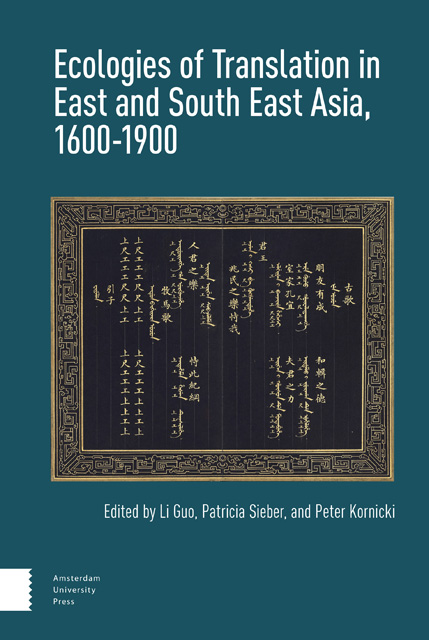Book contents
- Frontmatter
- Table of Contents
- Introduction: Scriptworlds, Vernacularization, and Shifting Translation Norms
- 1 On Not Being Shallow: Examination Essays, Songbooks, and the Translational Nature of Mixed-Register Literature in Early Modern China
- 2 A Faithful Translation: Tsūzoku sangokushi, the First Japanese Translation of Sanguozhi yanyi
- 3 Romance of the Two Kingdoms: Okajima Kanzan’s Chinese Explication of ‘The Annals of Pacification’ (Taiheiki engi)
- 4 Speaking the Sinitic: Translation and ‘Chinese Language’ in Eighteenth-Century Japan
- 5 ‘Body Borrowed, Soul Returned’: An Adaptation of a Chinese Buddhist Miracle Tale into a Vietnamese Traditional Theatrical Script
- 6 ‘Out of the Margins’: The Western Wing Glossarial Complex in Late Chosŏn and the Problem of the Literary Vernacular
- 7 Vernacular Eloquence in Fiction Glossaries of Late Chosŏn Korea
- 8 Imagined Orality: Mun Hanmyŏng’s Late Nineteenth-Century Approach to Sinitic Literacy
- 9 Linguistic Transformation and Cultural Reconstruction : Translations of Gorky’s ‘Kain and Artem’ in Japan and China
- Index
2 - A Faithful Translation: Tsūzoku sangokushi, theFirst Japanese Translation of Sanguozhiyanyi
Published online by Cambridge University Press: 16 November 2022
- Frontmatter
- Table of Contents
- Introduction: Scriptworlds, Vernacularization, and Shifting Translation Norms
- 1 On Not Being Shallow: Examination Essays, Songbooks, and the Translational Nature of Mixed-Register Literature in Early Modern China
- 2 A Faithful Translation: Tsūzoku sangokushi, the First Japanese Translation of Sanguozhi yanyi
- 3 Romance of the Two Kingdoms: Okajima Kanzan’s Chinese Explication of ‘The Annals of Pacification’ (Taiheiki engi)
- 4 Speaking the Sinitic: Translation and ‘Chinese Language’ in Eighteenth-Century Japan
- 5 ‘Body Borrowed, Soul Returned’: An Adaptation of a Chinese Buddhist Miracle Tale into a Vietnamese Traditional Theatrical Script
- 6 ‘Out of the Margins’: The Western Wing Glossarial Complex in Late Chosŏn and the Problem of the Literary Vernacular
- 7 Vernacular Eloquence in Fiction Glossaries of Late Chosŏn Korea
- 8 Imagined Orality: Mun Hanmyŏng’s Late Nineteenth-Century Approach to Sinitic Literacy
- 9 Linguistic Transformation and Cultural Reconstruction : Translations of Gorky’s ‘Kain and Artem’ in Japan and China
- Index
Summary
Abstract
Tsūzoku sangokushi(A Popularized History of the Three Kingdoms,1689-91) was one of the first completetranslations of Luo Guanzhong's Sanguozhi yanyi to appear inany language. Its influence on Japanese literatureof the eighteenth and nineteenth centuries wasevident across a broad range of genres. This paperexamines the context in which Tsūzoku sangokushi was translated andwhat it can tell us about Japanese readership ofChinese texts just prior to the explosion ofinterest in vernacular fiction. The paper arguesthat the translation of Tsūzoku sangokushi was motivated not somuch by interest in the work as an exemplar ofvernacular narrative but rather for its livelyaccount of a story loosely based on historicalevents.
Keywords: Chinese vernacularnarrative, popularization, script choice, Japanesetranslation
Romance of the ThreeKingdoms (Sanguozhiyanyi) has enjoyed a broad readership inits original format and in various adaptationsthroughout East Asia for centuries, and Japan is noexception. A complete translation of the text intoJapanese was published as Tsūzoku sangokushi [A PopularizedHistory of the Three Kingdoms] in Kyoto between 1689and 1691, the second complete translation of thetext to be realized, following the Manchu versionroughly four decades earlier. The book was animmediate hit, with other translations quicklyemerging to ride the coattails of its success. Thetremendous popularity that Tsūzoku sangokushi enjoyed and the deepimpression it made on the reading public are evidentin the numerous digest versions, cross-mediaadaptations, and even irreverent parodies thatproliferated in various genres through the end ofthe Edo period and beyond. Nearly a century and ahalf after its appearance, the translation had lostnone of its vitality, for its text was used,essentially unchanged, as the basis for Ehon tsūzoku sangokushi [APopularized History of the Three Kingdoms: AnIllustrated Book], published in the late 1830s.Adorned with some 400 exquisite illustrations byKatsushika Hokusai's disciple Katsushika Taito II,the new presentation of the now classic translationsoon became a bestseller, its more accessible formatbringing the work into the hands of an even wideraudience.
- Type
- Chapter
- Information
- Publisher: Amsterdam University PressPrint publication year: 2022

